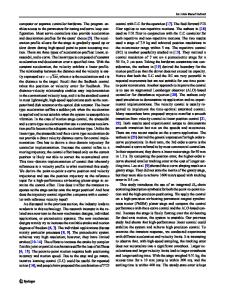Brachistochronic Motion of a Material Point on a Transcendental Surface
- PDF / 214,022 Bytes
- 9 Pages / 595.276 x 790.866 pts Page_size
- 35 Downloads / 283 Views
International Applied Mechanics, Vol. 56, No. 3, May, 2020
BRACHISTOCHRONIC MOTION OF A MATERIAL POINT ON A TRANSCENDENTAL SURFACE
V. P. Legeza
A new brachistochrone problem of the motion of a material point on a transcendental surface between two given points in a vertical uniform field of gravity is considered. The surface is a cut horizontal cylinder whose directrix is a cycloid, and generatrix is straight lines parallel to the horizontal axis. Energy dissipation is neglected. A time functional is obtained and a differential equation is derived for a single parameter that describes the form of brachistochrons in the problem. Spatial parametric equations of the brachistochronic motion of a material point on a surface are obtained. The fast response time is determined. Keywords: brachistochrone problem, transcendental surface, cycloid, time functional, fast response time Introduction. The variational problem under consideration is related to the dynamics of a non-free material point. In this problem, the point brachistochronically moves in a given force field over a fixed transcendental surface. The relevance of the problem is explained by the following applied problem associated with the practical use of various devices for vibration protection of carrying objects. When operating dampers, shock absorbers, and suppressors to protect load-bearing objects, various criteria for the quality of their operation are used. In some cases, the main criterion for their operation is minimum displacements of certain points of the carrying object, in other cases, it is minimum stresses (moments) in the most dangerous sections occurring during forced vibrations; in yet other cases, the criterion is that it is necessary to decrease the amplitudes of forced oscillations to a certain value in a minimum time. These criteria can be met only with appropriate tuning of the natural frequency of the damper to that of the carrying body in the resonance area. However, in almost all absorbers (including the pendulum-type ones), the natural frequency is not stable and strongly depends on the amplitude of hydraulic fluid. In other words, this relationship is non-linear and at large amplitudes of the carrying body, the vibrations are not isochronous. This factor does not enable tuning the damper to the natural frequency of the carrying body. While researching, it has been found that roller dampers and seismic shock absorbers that have working rolling surface in the form of a generalized brachistochrone for a cylinder or a ball [12–14] possess the isochronous property. In addition, during the operation of these absorbers, one more important property of the brachistochrone, namely, the fact that the roller moves over the brachistochronic surface in a minimum time, can be used. This makes it possible to decrease the amplitudes of forced vibrations of the carrying body to a specified value in the shortest time. The author is the first to suggest a new design of a roller damper based on a brachistochrone for a cylinder or a ball [14]. The main l
Data Loading...











